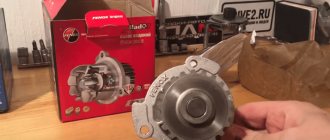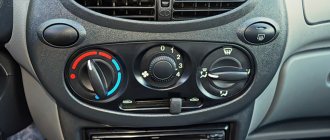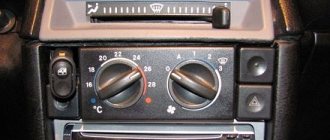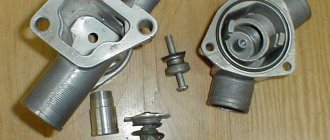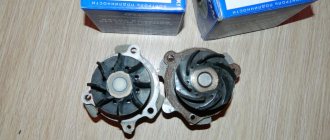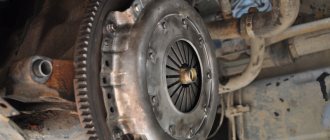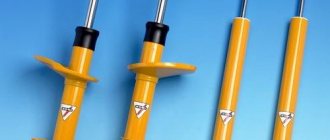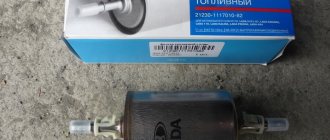The power unit is, of course, the most important component of any car. But do not forget that the main condition for its uninterrupted operation is high-quality cooling. Therefore, the cooling system plays an important role in the operation of any machine. In this case, it is worth paying considerable attention to the water pump (that is, the pump), which ensures the circulation of antifreeze in the system. Drivers often independently repair or replace the pump on a VAZ classic, since these procedures cannot be called complex and time-consuming.
POMP VAZ 2107
On cars with a liquid cooling system, including the VAZ 2107, one of the main elements responsible for maintaining the operating temperature of the engine is the pump. Thanks to this unit, the circulation of coolant is ensured. If problems arise or if the water pump fails, the normal operation of the power unit is disrupted, which can lead to serious consequences and expensive repairs.
The pump circulates coolant through the engine cooling system
PURPOSE
The operation of the pump is aimed at continuous circulation of coolant (coolant) through the engine cooling jacket. The antifreeze is heated under the influence of the rubbing elements of the power unit, and the necessary pressure in the system is created by a water pump. The liquid is directly cooled in the main radiator, after which the coolant again enters the cooling jacket. If circulation is interrupted for at least 5 minutes, the motor will overheat. That is why it is so important to monitor the proper operation of the node in question.
PUMP DESIGN
On the VAZ 2107, as on many other passenger cars, the pump has almost the same design. The unit consists of a housing with a central shaft located inside, on which the impeller is fixed. The shaft is secured against axial displacement by means of a bearing, and the tightness of the structure is ensured by an oil seal that prevents coolant leakage. There is a hole in the pump cover through which the shaft comes out, where the pulley hub and then the pulley itself are attached to it. A belt is put on the latter, which on the “seven” rotates the generator and pump from the crankshaft. On modern cars, the pump rotates via a timing belt.
The main elements of the pump are the housing, shaft with bearing, impeller and oil seal
WHERE IS
On classic Zhiguli models, the pump is located on the front of the power unit and is attached not to the block, but through a separate housing. By opening the hood, you can easily notice both the pump pulley and the assembly itself.
The pump is located in the front part of the engine and is part of the cooling system of the power unit: 1 - supply pipe to the cabin heater; 2 - expansion tank; 3 - radiator; 4 - pump; 5 — thermostat; 6 — manifold heating tube; 7 — return pipe from the cabin heater
WHICH PUMP IS BETTER
For the VAZ 2107, water pumps with catalog numbers 21073–1307010, 2107–1307011–75 and 2123–1307011–75 are suitable. The last two options have an enlarged impeller and a slightly reinforced structure. Initially, these pumps were produced for Niva. The slightly higher cost of such pumps is fully justified by the better performance.
On “Sevens” equipped with both injection and carburetor engines, the same water pumps are installed, and their repairs are carried out in the same way.
The old pump has an impeller made of cast iron, and the new one is made of plastic.
The product in question is produced today by many companies, but the most popular are:
- luzar;
- Hepu;
- TZA;
- Phoenix.
At the car market you can find pumps with impellers made of different materials: plastic, cast iron, steel. Products with plastic impellers, which are equipped with embossed and elongated blades, receive positive reviews. Elements made of cast iron are characterized by lower performance, and as for steel ones, they are susceptible to corrosion and are quite often fake.
The housing is replaced if it is damaged, and in other cases only the pumping part is changed
The pump can be purchased either complete with a housing or separately. If the housing is not damaged, then it is enough to replace the pumping part. If the design has serious flaws or is completely broken, then you cannot do without replacing the housing.
VIDEO: WHICH PUMP TO PUT ON THE “CLASSIC”
Bleeding the system
You cannot do without this, since you will have to pour antifreeze into the system. Just follow these steps:
Open the heater tap and position the car so that the front is slightly higher than the rear. This will ensure that the antifreeze evenly fills the entire system. Make sure all drain holes are closed. Fill the radiator with antifreeze as much as possible. Squeeze the pipes with your hands to force the air out of them. Close the cap on the radiator and fill the expansion tank with antifreeze just above the bottom mark. Start the engine and warm it up to operating temperature
Pay attention to whether there is any fluid leakage from the system. If the pump on the VAZ-2106 works correctly, then cooling will occur in normal mode. To get rid of air pockets, squeeze the pipes with your hands
But don't forget that they are hot, so use gloves.
When working with the cooling system, be sure to follow safety regulations. If antifreeze gets on your hands, nothing will happen. But do not allow it to get into your respiratory tract or onto your eyes. If this happens, seek medical attention immediately. You need to be especially careful with hot antifreeze - if the pipe breaks, you can get a very severe burn.
If the VAZ 2107 pump is leaking, it is not recommended to drive such a car for a long time. Of course, it still depends on how severe the leak is - if the liquid drips slightly, then you can postpone the repair. But if antifreeze disappears at a rate of several hundred grams per day, you cannot hesitate. It is necessary to carry out repairs as soon as possible, now you will find out how to do it correctly.
What is a pump?
First, a few words about what a VAZ 2107 pump is and what you can expect if it suddenly leaks. In fact, this is an ordinary liquid pump, which consists of a housing, a rotor, an impeller, and a drive pulley.
On classic series cars, it is driven from the crankshaft using an alternator belt. It is also worth mentioning that on older machines a fan was installed on the drive pulley.
But this was at a time when electric radiator fans were not even dreamed of.
What happens if the VAZ 2107 pump leaks? First, a lot of coolant is lost. Therefore, before each trip you need to fill the expansion tank with antifreeze. Secondly, heat transfer deteriorates, and a significant increase in temperature is possible. Thirdly, air pockets may appear, which also cause poor engine cooling.
SIGNS OF A PUMP FAILURE
Sooner or later, problems arise with the pump and the unit fails. This may be due to both the high mileage of the car and the installation of a low-quality product. Therefore, it is worth considering what malfunctions may occur with the pump and what to do in this or that case.
SEAL LEAK
It is quite easy to detect coolant leakage through the oil seal: a puddle usually appears under the car. If the sealing element is damaged, for example, as a result of wear, antifreeze will get to the pump bearing, as a result of which the lubricant will be washed out of the device, and the part itself will soon collapse. To prevent this from happening, it is necessary to periodically inspect the car and eliminate possible problems.
If the oil seal fails, antifreeze leaks from the pump.
NOISE APPEARANCE
If extraneous noise is heard from the pump area while the engine is running, this indicates an imminent breakdown of the unit. The most likely cause of noise is failure of the bearings or weak fastening of the impeller. In any case, the part needs to be dismantled, subsequently damaged, repaired or replaced.
VIDEO: HOW THE PUMP ON A VAZ MAKES NOISE
REDUCED PRODUCTIVITY
Whatever antifreeze is used in the cooling system, it is a chemical substance. Over time, erosion occurs in the pump housing or impeller, which can lead to a decrease in the flow of pumped liquid. As a result, the motor may overheat with all the ensuing consequences. Therefore, if the coolant temperature sensor on the instrument panel begins to exceed +90˚С (operating temperature), it is worth thinking about a possible replacement of the pump or, at least, a revision of this unit.
INCREASED VIBRATION
If increased vibration comes from the pump area, first of all you need to inspect the pump housing in the bearing area: sometimes cracks may appear on it. It would also be useful to check the correct installation of the generator belt, pump pulley and fan. If faulty parts are found, replace them.
DIRTY COOLANT
If the coolant has not been changed for a long time, problems may arise with the pump. It is not difficult to determine if the system is dirty: the color of the liquid will be brownish instead of red, blue or green. If the antifreeze turns black, most likely oil has entered the cooling system.
Dirty antifreeze indicates the need to replace it
HOW TO CHECK THE OPERATION OF THE PUMP
You can check the functioning of the pump yourself. To do this you will need:
- Warm up the engine to operating temperature and clamp the upper pipe leading to the radiator. If you feel a surge in pressure when you release it, then the pump is working normally.
- There is a drain hole on the pump so you should pay attention to it. If the oil seal does not cope with its functions, then antifreeze may protrude from this hole.
- While the engine is running, you need to listen to extraneous sounds. If a hum is heard from the pump, then most likely the bearing has become unusable. You can check it with the engine turned off by shaking the pump pulley. If play is felt, it means the bearing needs to be replaced.
Work on checking the pump with the engine running should be carried out carefully, not forgetting about the rotating fan and high coolant temperature.
Water pump design
The appearance of water pumps may be different (the design features of power plants from different manufacturers affect them), but they are all structurally the same and consist of:
- frame;
- axis;
- pulley or gear;
- impeller;
- stuffing box;
- bearings.
Frame
The housing is a load-bearing element and contains all of the listed components, except for the impeller and pulley, which are located on the outer sides. The body is most often made of aluminum. It is also used to attach the pump to the cylinder block. To ensure tightness at the junction of the housing and the motor, a gasket is installed between them.
To prevent antifreeze and moisture from accumulating in the area where the bearings are located, a drainage hole is made in the housing.
Axle, bearings, oil seal
Inside the case there is a steel axis mounted on two bearings, which ensures ease of rotation. The axle is usually made of steel, which provides high strength.
The bearings are sealed, meaning there is no access to them. They are lubricated using the supplied lubricant, which should be enough for the entire service life of the pump. But on some old trucks, there was a grease nipple in the body, so their bearings could be lubricated.
Video: Selecting a Pump. Pump LUZAR.
https://youtube.com/watch?v=Lyfn85yPu7M
To prevent contact of the working fluid with the bearings, a sealing rubber element - an oil seal - is installed on the impeller side. Without it, antifreeze would get into the bearing operating area, which would lead to their rapid wear.
Pulley, impeller
The pulley or gear is the element that receives the force from the crankshaft. The pulley is used on cars in which the gas distribution mechanism is driven by a chain drive. Because of this design solution, it was not possible to organize the transmission of force to the pump by a chain. Therefore, to ensure rotation of the pump, a separate belt drive is used, which can additionally provide operation of other engine attachments - power steering pump, compressor, etc.
In cars in which the timing drive is provided by a toothed belt, it is also used to ensure the operation of the pump. That is, one belt engages both the timing belt and the pump. And so that there are no losses due to slipping when transmitting force, a gear is used as a drive element on the pump.
A pulley or gear is rigidly connected to an axle. For this, either a keyed connection or a bolted connection is used.
On the other side, an impeller is mounted on the axis - a special disk with wings applied to it in a special way. It is most often made of aluminum, although there are also impellers made of plastic. Its landing on the axle is also rigid.
Replacing the pump, belt, coolant and wheel
...I drove in fear that the pump might jam, but the car waited for repairs, losing a little coolant, but it didn’t let me down... (Yes, a year or two ago I heard how the bearings in the pump crunch in winter, it was necessary to lubricate it, fortunately there is a plug for a screwdriver for the oil can in the bearing, but I’m not an experienced pelvis fitter and I ruined the pump with bad antifreeze and lack of lubrication...)
AvtoVAZ’s motto is always wounded, never killed!
I climb under the car in the morning...what’s wrong with the wheel?
Air, where are you going?
And here it is, everything immediately became clear, I haven’t parked under the driveway for a long time, and last night for the first time in a couple of years I drove up for a couple of hours to load things, well, in general, everything was the same as before, many years ago, nothing has changed, the screw is good, brand new . Thank God I no longer live in this yard.
I removed the mudguards... drained the original antifreeze (antifreeze) which looks like used oil...
Oh, everything is leaking here, poor Gennady
And here's where it comes from...
The big difficulty is to unscrew everything that no human hand has touched for the last 10 years.
Unscrewing the nuts is an adventure...
Initially, I decided to remove it together with the pulley, well, it’s inconvenient to remove the pulley, but it didn’t work out, I had to remove the pulley using two 13mm wrenches, and then hit the body with a hammer so that the semi-pump would separate from the body.
Do you think it still fits?..
And here is the removed factory pump...
The seat has been cleared of the old gasket...
Old factory pump and new Luzar Turbo (God help us with quality)
We simply screw the new pump onto the gasket without sealant (nothing seems to be leaking)…
It’s probably time to send the factory belt to rest, in the trunk, in reserve...
Fortunately, I always have a new belt in the trunk, the old belt is noticeably thinner, a little cracked
Work environment
I couldn’t get the new belt to tighten, it wouldn’t fit, I put the old one back, tightened it, and the adjustment was already at the limit, I drove for a week on the old one, and today I integrated the new belt by removing the pump pulley and installing them at the same time...
The pump has been replaced, the system needs to be flushed, I was afraid to use chemicals so that nothing would leak... I poured in distilled water, warmed it up, cooled down, started it for a minute so that the dirt would rise and drained it.
Rinse distilled water of the first run
While the car is cooling down, you can change the tire...
I ran the water three times a day, each time it was much cleaner, but it still blended in with the black tint... I decided to ride on the water for a week... ... I drove for a week and 200 km on the water...
The water is now not dark, but yellow...probably it’s not worth driving on the water...
I run the water again, drain it, and it wasn’t there, fill it with antifreeze (antifreeze), otherwise distillation and fuel for half a day of warming up will soon cost more than antifreeze...
FELIX G12+, let's see...
Don’t forget to tighten the drain plugs...you need to purchase drain taps and screw them into the block/radiator before draining...
And a beautiful liquid poured into the bowels of the engine...
By the way, about air locks, in some manuals you need to remove one of the throttle valve pipes to let air out, in others you need to unscrew the sensor from the cylinder head... But I didn’t do this, I just added antifreeze (antifreeze) with the engine running and controlled the heating of the gas reducer and throttle valve, if it gets warmer then there is no plug...
10 liters of FELIX g12+, everything has just gone to the bottom, you still need to buy it for refilling
